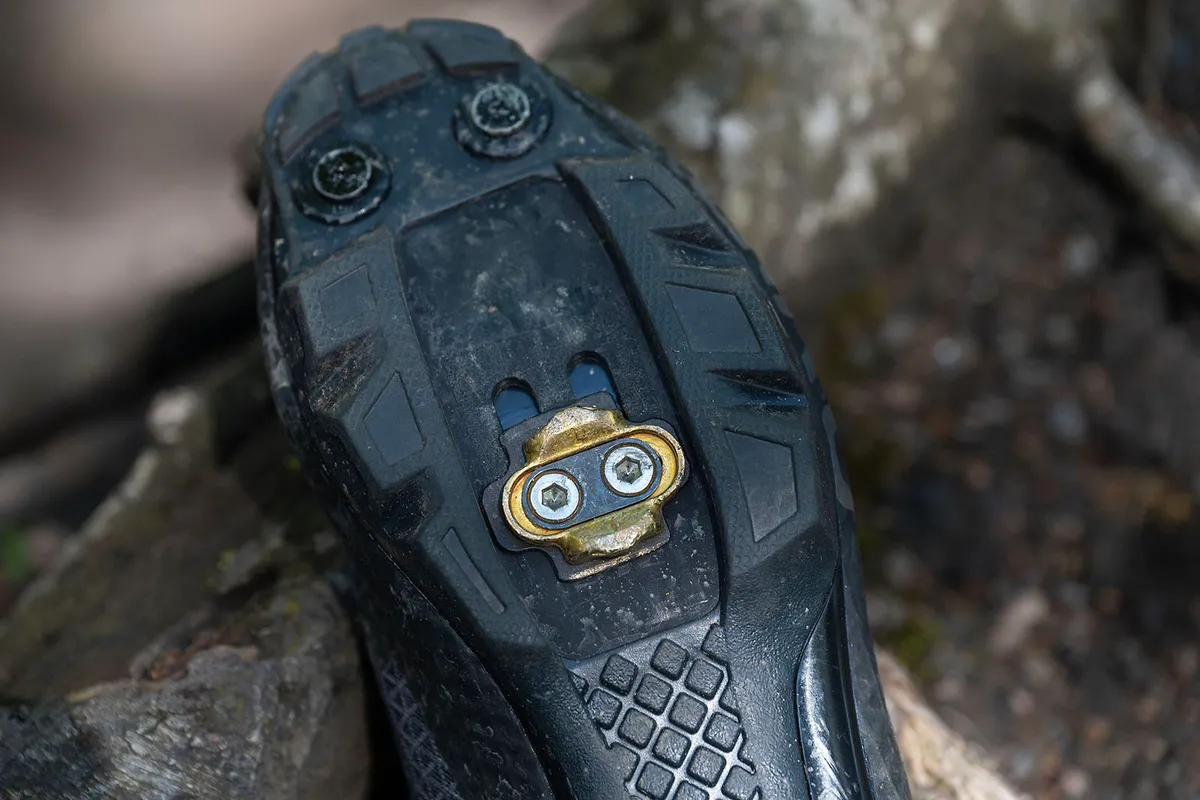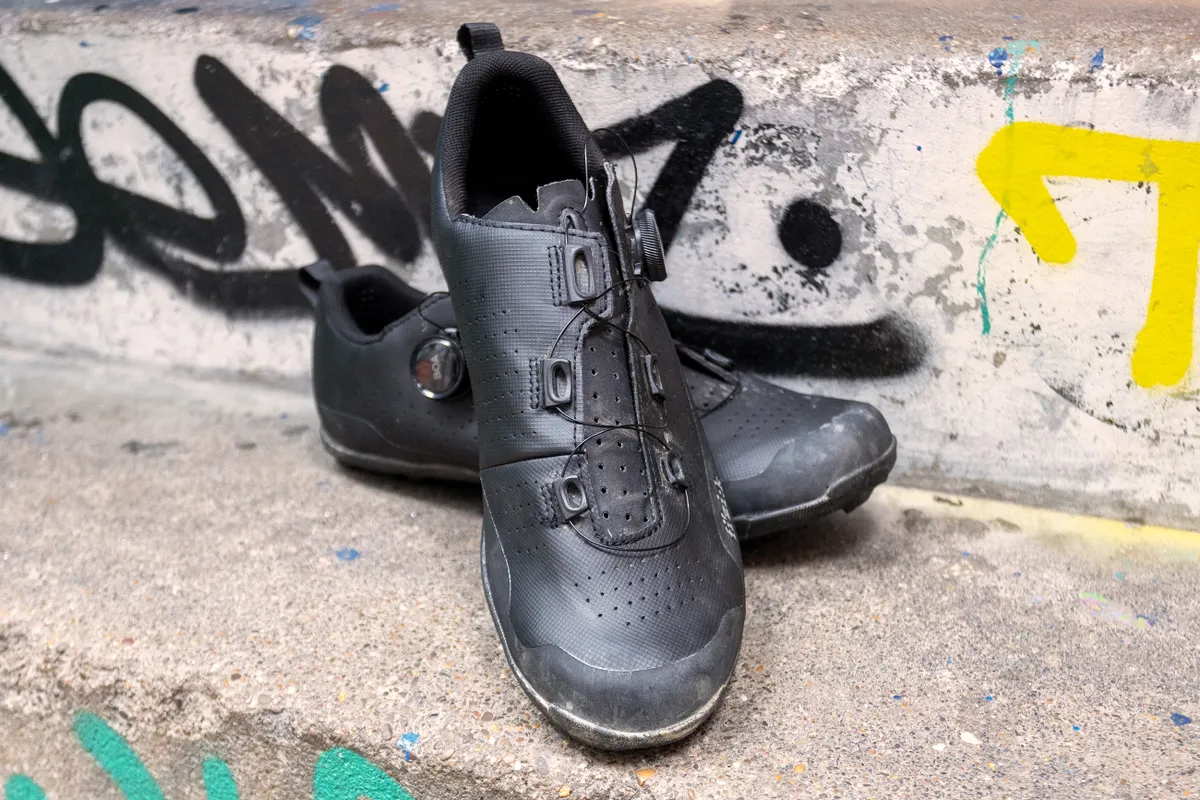Giro’s Rincon mountain bike shoes are designed for more than just trail riding, happily taking on gravel jaunts and commuting duties when necessary.
Their incredibly comfortable upper, secure, locked-in fit and airy feel make them ideal for rattling out the miles on warm days.
It helps that there’s a decent amount of flex through the sole to prevent you looking like Bambi on ice when you do need to get off and walk about.
Their fit and feel won’t suit everyone, though, especially if you value efficiency and power transfer above all else.
Giro Rincon shoes specifications and details

The upper of the Rincon is constructed from Giro’s thick, mesh-like ‘Synchwire’ material, which is pieced together with a thermo-bonded exo-structure. This feels very soft and malleable, as well as being light and airy.
Up-front, a toughened toe bumper offers some genuine protection.
Giro has opted for a Boa ratchet dial teamed with a Velcro strap to lock your feet in securely. The Boa dial can be popped up for a quick release of tension and easy exit.
Underneath, a nylon composite outsole forms the backbone of the Rincon and provides the stiffness required for efficient pedalling. Chunky tread blocks surround the cleat pocket and heel for traction off the bike, while there are fixtures for toe studs if you want even more grip.
Thankfully, Giro has joined the rubber tread blocks at the front and back of the outsole with a section of textured rubber through the middle of the shoe. This is great for boosting traction if you’re unclipped and stood on the pedals, and far less skatey than some shoes can feel.
The weight of my EU42 shoes, with Crankbrothers cleats fitted, is 702g, which is really light.
Giro Rincon shoes performance

Getting the Rincons onto your feet is a quick and easy affair, as is perfecting the tension across the top of the foot with the Boa dial and Velcro strap.
Coupled with the soft, very flexible upper, I found them comfortable almost instantly, though would have preferred a little more room around my toes. This didn’t cause any real discomfort, it just meant I couldn’t let my toes splay out as I can in other mountain bike shoes.
It helps that the heel and ankle cuff feel particularly well padded, and once you’ve cinched up the closure, secure with next to no slip as you walk or move about on the bike.
Although the bonded sections of the upper will offer some water-resistance, the mesh-like panels (which make up the bulk of the upper) won’t prevent splashes getting in.
On the flipside, these sections help to make the Rincons feel light and airy, and ideal for long rides in the heat.
While the sole feels reasonably stiff, there’s still enough flex at the toe to keep things feeling natural and less penguin-like off the bike.
That flex goes largely unnoticed when you’re seated and powering along, though get up out of the saddle and start putting in some effort and you’ll feel the Rincon bow ever so slightly around the pedal.
This resulted in slight ache in the middle of my feet during longer high-torque efforts, though it dissipated quickly once seated again. Clipless pedals with larger platforms help alleviate this, but on smaller pedals, this sensation is hard to ignore.
There’s also ample space within the cleat slots to suit those who prefer a more rearward cleat position, which is important.
How do the Giro Rincon shoes compare?

Compared to the Fizik Terra Atlas shoes, which cost exactly the same as the Rincons, I’d say it’s a very even battle.
Both offer some flex through the sole, which can be felt on smaller clipless pedals when really grinding out the watts.
This means neither are perfect in that regard, although that flex enhances feel and feedback from the pedal beneath your feet, which is a plus in more technical terrain.
While the Rincons offer a lighter, airier and more comfortable upper, the Terra Atlas works a little better with smaller clipless pedals.
If you’re using larger clipless pedals, the Giros would be my recommendation.
Giro Rincon shoes bottom line

Giro has made the Rincons feel light, airy and comfortable, and great for hammering out the miles on a balmy summer’s day.
The flex through the sole helps with walking off the bike and gives plenty of feel and feedback from the pedals beneath. However, when you’re really putting the power down, it can create some temporary discomfort compared to others with stiffer outsoles.
It’s the soft, malleable upper that makes these shoes nice to wear, though, more than anything else.
In an ideal world, I’d prefer the shape of the toe box to be squarer and less tapered, but that’s being very picky.
How we tested | trail and XC clipless mountain bike shoes
We've tested nine of the newest and most interesting trail and cross-country focused clipless shoes.
To identify the key differences, we’ve gone out into the wilderness to pedal mile after mile, often with a different shoe on each foot. This may look weird, but there’s no better way to highlight those all-important details.
On top of that, doing long rides around battered trail centre loops and taking part in an XC race has helped us work out each pair’s strengths and weaknesses.
Products on test
- Bontrager Evoke
- Five Ten Kestrel Boa
- Fizik Terra Atlas
- Giro Rincon
- Northwave Rockit Plus
- Rockrider Race 700
- Scott MTB Team Boa
- Shimano ME5
- Specialized Recon 2.0
Product
| Brand | Giro |
| Price | A$257.00, €160.00, £160.00, $196.00 |
| Weight | 702g |
Features
| Shoe closure | dial |
| Shoe closure | velcro |
| Cleat fitting | 2bolt |
| Sole | Nylon-composite 2-bolt plate with dual-injected rubber |
| Features | Sizes: 39 - 50 Upper: One-piece Synchwire™ Colours: Black, Dark Shadow/Gum, Port Grey |
